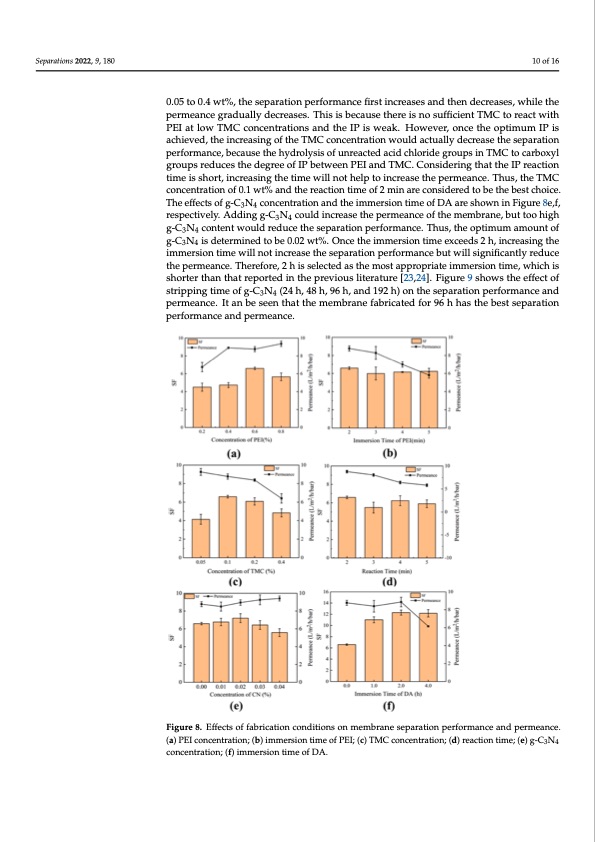
PDF Publication Title:
Text from PDF Page: 010
Separations 2022, 9, 180 10 of 16 0.05 to 0.4 wt%, the separation performance first increases and then decreases, while the permeance gradually decreases. This is because there is no sufficient TMC to react with PEI at low TMC concentrations and the IP is weak. However, once the optimum IP is achieved, the increasing of the TMC concentration would actually decrease the separation performance, because the hydrolysis of unreacted acid chloride groups in TMC to carboxyl groups reduces the degree of IP between PEI and TMC. Considering that the IP reaction time is short, increasing the time will not help to increase the permeance. Thus, the TMC concentration of 0.1 wt% and the reaction time of 2 min are considered to be the best choice. The effects of g-C3N4 concentration and the immersion time of DA are shown in Figure 8e,f, respectively. Adding g-C3N4 could increase the permeance of the membrane, but too high g-C3N4 content would reduce the separation performance. Thus, the optimum amount of g-C3N4 is determined to be 0.02 wt%. Once the immersion time exceeds 2 h, increasing the immersion time will not increase the separation performance but will significantly reduce the permeance. Therefore, 2 h is selected as the most appropriate immersion time, which is shorter than that reported in the previous literature [23,24]. Figure 9 shows the effect of stripping time of g-C3N4 (24 h, 48 h, 96 h, and 192 h) on the separation performance and Separations 2022, 9, x FOR PEER REVIEW 11 of 17 permeance. It an be seen that the membrane fabricated for 96 h has the best separation performance and permeance. Figure 8. Effects of fabrication conditions on membrane separation performance and permeance. Figure 8. Effects of fabrication conditions on membrane separation performance and permeance. (a) (a) PEI concentration; (b) immersion time of PEI; (c) TMC concentration; (d) reaction time; (e) g-C3N4 PEI concentration; (b) immersion time of PEI; (c) TMC concentration; (d) reaction time; (e) g-C3N4 concentration; (f) immersion time of DA. concentration; (f) immersion time of DA.PDF Image | Nanofiltration Membrane Using Polydopamine Carbon Nitride

PDF Search Title:
Nanofiltration Membrane Using Polydopamine Carbon NitrideOriginal File Name Searched:
separations-09-00180.pdfDIY PDF Search: Google It | Yahoo | Bing
Product and Development Focus for Infinity Turbine
ORC Waste Heat Turbine and ORC System Build Plans: All turbine plans are $10,000 each. This allows you to build a system and then consider licensing for production after you have completed and tested a unit.Redox Flow Battery Technology: With the advent of the new USA tax credits for producing and selling batteries ($35/kW) we are focussing on a simple flow battery using shipping containers as the modular electrolyte storage units with tax credits up to $140,000 per system. Our main focus is on the salt battery. This battery can be used for both thermal and electrical storage applications. We call it the Cogeneration Battery or Cogen Battery. One project is converting salt (brine) based water conditioners to simultaneously produce power. In addition, there are many opportunities to extract Lithium from brine (salt lakes, groundwater, and producer water).Salt water or brine are huge sources for lithium. Most of the worlds lithium is acquired from a brine source. It's even in seawater in a low concentration. Brine is also a byproduct of huge powerplants, which can now use that as an electrolyte and a huge flow battery (which allows storage at the source).We welcome any business and equipment inquiries, as well as licensing our turbines for manufacturing.| CONTACT TEL: 608-238-6001 Email: greg@infinityturbine.com | RSS | AMP |